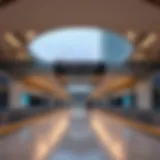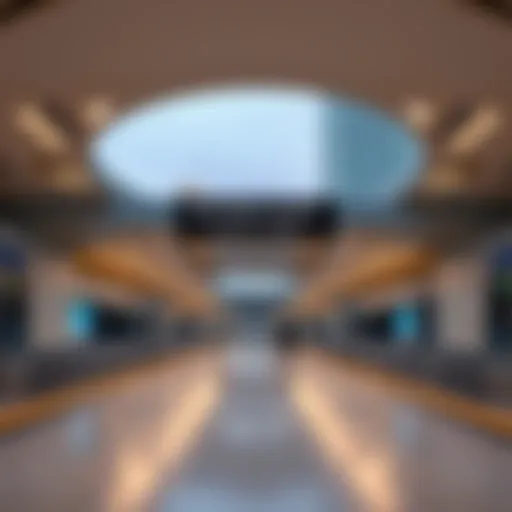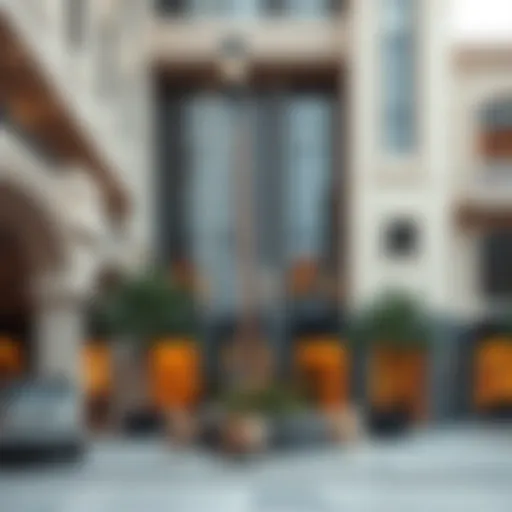Exploring the Architectural Essence of Dar Al Riffa
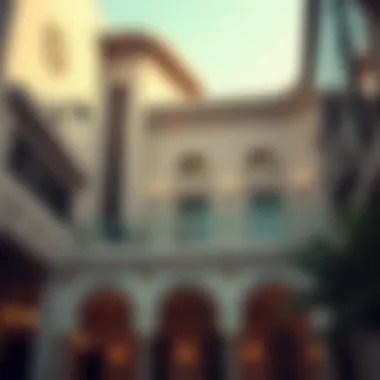

Intro
The Dar Al Riffa Building stands as a striking testament to Dubai's architectural ambition and its real estate evolution. Nestled among towering skyscrapers and bustling streets, this structure is not merely a physical entity but a symbol reflecting the profound cultural transformations that define the rapidly changing cityscape. It blends traditional aesthetics and modern innovation, making it significant for anyone interested in Dubai's real estate market.
Riffling through its photographs, one unveils layers of history, craftsmanship, and investment potential. Each image tells a story—of meticulous design, engineering prowess, and the surrounding environment's subtle influences. An exploration of this building provides insights not just into the bricks and mortar, but also into the people, market trends, and cultural narratives that bring it to life.
In this deep dive, we will unravel the architectural marvels embedded in Dar Al Riffa's structure, explore its essence within the broader context of its locale, and analyze the current market trends. The implications for potential home buyers, investors, and real estate connoisseurs are substantial as we piece together this patchwork of photography, history, and market analysis. Prepare to embark on a comprehensive journey that combines visual representation with concrete insight into one of Dubai's most intriguing buildings.
Prologue
The Dar Al Riffa Building stands as a testament to modern architectural ingenuity in the heart of Dubai. As the skyline of this vibrant city continues to transform, understanding the significance of structures like Dar Al Riffa becomes increasingly crucial. This article is not just a stroll through its corridors; it is a deep dive into what makes this building a worthy subject of both admiration and scholarly inquiry.
For investors and home buyers, the Dar Al Riffa Building is more than just a set of walls and windows; it encapsulates the trends in real estate, showcasing how architectural aesthetics can align with market demands. Real estate agents and property managers can benefit from grasping the intricate details of a property that stands out in a crowded market. Renters, too, can gain insights into why this building might be their next home, not just for its physical attributes but also for the lifestyle it offers.
By focusing on the photographic representation of the Dar Al Riffa, this article reveals how visuals can enhance our understanding of a building's character and placement. Photography bears the power to highlight angles and details that might go unnoticed in passing. The smallest design nuances can, through the right lens, become focal points that resonate with cultural significance and aesthetic appreciation.
In exploring topics like the evolution of its architecture and the role photography plays in architecture, we aim to provide a comprehensive understanding of the Dar Al Riffa Building's impact. From historical context to current market trends, this inquiry allows readers to grasp not only the building itself but its role in the fabric of modern Dubai.
"Architecture is the learned game of spaces." – Le Corbusier
This quote encapsulates the essence of our exploration of the Dar Al Riffa Building. As we move through different sections, we'll reveal how this architectural marvel adapts and thrives, becoming a significant player in Dubai's ever-evolving landscape.
Historical Background of the Dar Al Riffa Building
The significance of the historical context surrounding the Dar Al Riffa Building cannot be overstated. This section dives into the rich tapestry of events, circumstances, and influences that contributed to the origin and development of this architectural gem. Understanding the historical background is crucial for investors and real estate enthusiasts because it provides insight into the building's value and its role in the evolution of Dubai's architectural landscape.
Origins and Development
The Dar Al Riffa Building, located in what is often referred to as the heart of Dubai, has roots that stretch back several decades. Initially conceived during a period of rapid urbanization in the 1990s, the project emerged from the vision of local developers keen on expanding Dubai's architectural offerings. This was due, in part, to the influx of tourists and expatriates seeking modern, comfortable accommodation paired with traditional aesthetics.
The design of Dar Al Riffa reflects Dubai’s unique blend of the modern and the traditional. Through its strategic planning and tasteful architecture, the building incorporates elements that echo the city’s rich cultural heritage. The original intention was not just to create a living space but also a landmark that captures the essence of Dubai's transformation into a global hub.
Interestingly, the construction of Dar Al Riffa began at a time when the city was still figuring out its identity. While imposing skyscrapers were rising along the skyline, this building serves as a reminder of Dubai's historical roots, drawing from Islamic architectural principles. The mixture of old and new is one of the many aspects that attract potential investors and residents alike today.
Architectural Evolution
As the world watched Dubai evolve from a modest trading port into a bustling metropolis, the architectural scene in the city began to reflect this transformation. The Dar Al Riffa Building underwent multiple phases of architectural evolution, adapting to changing trends while maintaining its unique character.
The early designs heavily featured intricate details and traditional motifs, characteristic of Islamic architecture. Over time, however, the design embraced contemporary styles, exhibiting a shift toward minimalism and sleek lines, yet without losing its cultural essence. This evolution is indicative of a broader trend seen across the Emirate, where modern functionality meets the historical narrative of the region.
"Architectural evolution in Dubai isn’t just about aesthetics; it’s a reflection of lifestyle changes, societal growth, and cultural evolution."
From energy-efficient systems that reflect today’s sustainability standards to innovative materials that enhance durability, Dar Al Riffa has adapted well to modern demands. Aspects like open spaces, large windows for natural light, and communal areas reflect a shift towards more integrated living environments, where community and individualism play equal parts.
To summarize, the historical background of the Dar Al Riffa Building lays the framework for understanding its architectural significance. Recognizing its origins and ongoing evolution not only enriches one’s appreciation for the structure itself but also provides insights into the evolving narrative of Dubai, making it an attractive destination for investors and home buyers alike.
For further exploration of Dubai's architectural journey, you might find these resources useful:
Architectural Features
Understanding the architectural features of the Dar Al Riffa Building sheds light on its significance, both as a visual landmark and as a functional entity within Dubai's bustling urban landscape. The layers of design elements articulate not only aesthetic appeal but also deliberate architectural choices that cater to the needs of the occupants and the expectations of a modern society. These features blend tradition with contemporary design, making the building a standout example of architectural prowess.
Design Philosophy
The design philosophy behind the Dar Al Riffa Building is a testimony to bridging cultural heritage with modernity. The architects carefully wove traditional Arabic motifs into contemporary forms, a move that honors the past while looking toward the future. This philosophy is not merely about aesthetics; it embodies the essence of place, ensuring that the building resonates with its geographic and cultural surroundings.
- Contextual Relevance: The building's design considers its environmental context, taking into account local climate and cultural values.
- Functionality: Spaces are arranged to promote usability, allowing for both public interactions and private moments.
- Sustainability: Sustainable materials and energy-efficient systems reflect a growing awareness of environmental issues in modern architecture.
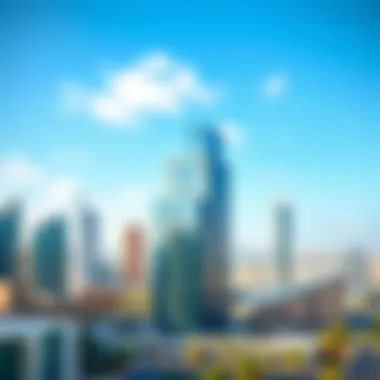

Exterior Design Elements
The exterior of the Dar Al Riffa Building presents a striking profile that is both inviting and imposing. Its facade is an intricate tapestry of colors and textures that draw on traditional motifs while employing modern materials. The careful juxtaposition of glass and stone creates a dynamic interaction with sunlight throughout the day.
- Facade Treatments: Diverse materials are utilized, from reflective glass that mirrors the skyline to textured stone that references local craftsmanship.
- Outdoor Spaces: Balconies and terraces offer not just aesthetic value, but serve as practical extensions of interior spaces, promoting outdoor living.
- Landscaping: The surrounding gardens not only enhance curb appeal but also provide a tranquil retreat amidst the urban hustle.
Interior Design Highlights
Stepping inside the Dar Al Riffa Building offers a sensory experience that melds warmth with sophistication. The interior design encapsulates the building's philosophy, showcasing careful attention to detail and functionality.
- Spatial Arrangement: Interior spaces are thoughtfully planned with an emphasis on flow and interaction, catering to social gatherings while ensuring privacy.
- Material Palette: A harmonious blend of luxurious fabrics, earthy tones, and traditional patterns creates a welcoming atmosphere.
- Artistic Elements: From custom artwork to unique light fixtures, every design choice serves a purpose, contributing to a narrative that celebrates both culture and modernity.
"The architectural features of the Dar Al Riffa Building are not just visual statements; they communicate a rich story of cultural identity and innovation."
Through these architectural features, the Dar Al Riffa Building stands as a beacon of modern design intertwined with cultural significance, making it not just a building, but a landmark that speaks to the evolving narrative of Dubai.
The Role of Photography in Understanding Architecture
Photography serves as a critical lens through which architecture can be understood and appreciated on multiple levels. In the case of the Dar Al Riffa Building, it transforms the structure into a narrative, allowing viewers to engage with its design and context in a way that mere observation cannot provide. This role is not just about capturing a building as it stands; it’s about conveying the essence of its architectural language and the cultural context it inhabits.
One might consider the key benefits of architectural photography:
- Visual Storytelling: Photography captures the spirit of a building, often telling stories that are missing in a plain description. For instance, the deep shadows cast by the intricate façades of the Dar Al Riffa can evoke a sense of mystery and grandeur, which words might find difficult to convey.
- Highlighting Design Elements: Through careful composition, a photograph can emphasize specific design features, such as the interplay of light and texture that characterizes the Dar Al Riffa Building. It's a way to illustrate those elements that might go unnoticed in a brief visit.
- Contextual Understanding: Well-composed images can also encapsulate a building’s relationship with its environment. For the Dar Al Riffa, positioning it within Dubai's bustling landscape brings to light its significance and how it complements or contrasts with neighboring structures.
This exploration of the Dar Al Riffa Building through photography not only raises awareness of its architectural significance but also invites a deeper appreciation of how such structures engage with their community and heritage. Photography is a vehicle that enhances interaction with architecture, transforming buildings from mere objects into vibrant experiences.
The Aesthetic of Architectural Photography
The aesthetic of architectural photography plays a vital role in how structures are perceived. At its best, this art form transcends the simple act of capturing an image. Rather, it emphasizes aspects such as form, scale, and composition. For the Dar Al Riffa Building, the way these elements are portrayed can shape identity and influence public perception.
Photographers may use a variety of approaches:
- Framing: A well-framed photograph can highlight symmetry and balance, shedding light on the permissions of space surrounding the building.
- Lighting: The golden hours of mornings and evenings cast shadows and colors that can amplify the aesthetic appeal of a building, highlighting its architectural dialogue. The Dar Al Riffa, bathed in the warm glow of a sunset, may evoke feelings of serenity and grace.
- Perspective: Choosing an angle can drastically alter the viewer's perception. A low-angle shot taken while standing in the adjacent plaza could enhance the building's height and grandeur, while a bird's eye view could offer insight into the intricate layout of its surroundings.
In the end, through careful aesthetic decisions, photographers breathe life into the stillness of a building, allowing viewers to feel its presence and understand its story.
Photographic Techniques Used
When capturing the architectural artistry of a building like the Dar Al Riffa, various techniques come into play to enhance the final outcome. Understanding these methods can enrich one’s appreciation for both the craft of photography and the architecture itself.
- Wide-Angle Lenses: Often used to capture expansive spaces without distortion, these lenses help to portray the entirety of a building's façade, particularly useful for structures that are visually overwhelming, like the Dar Al Riffa.
- HDR Imaging: High Dynamic Range imaging allows photographers to blend multiple exposures of the same scene, capturing a broader range of light and detail. This is particularly beneficial in the Dar Al Riffa Building, where the contrast between light-filled interiors and shadowed exteriors demands such technique.
- Long Exposure: At times, long exposure techniques can be employed to manipulate time and motion, allowing for light trails from cars passing nearby, giving life to the area surrounding the building while encapsulating its stillness.
- Detail Shots: Close-ups of unique textures or ornamental details can reveal much about the original intent of the architect. They showcase craftsmanship that demonstrates the building's cultural significance and intended narrative.
Each of these techniques contributes to a richer understanding of the Dar Al Riffa, further cementing photography's role as a crucial aspect of architectural analysis. In this digital age, where visuals reign supreme, photography remains an indispensable medium for deeper engagement with our architectural heritage.
A Photographic Journey Through Dar Al Riffa
Exploring the Dar Al Riffa Building through photographs is not just a visual exercise, it is a way to appreciate the intricate relationship between architecture and its surrounding environment. Photography serves as a bridge, helping to convey the building's essence and significance within the cultural and commercial landscape of Dubai. Each snapshot tells a story, capturing angles and elements that may not be easily described in words. This journey presents various facets of the structure, from grand exteriors to intimate interiors, revealing how light and space interact with design.
Exterior Shots
The exterior of the Dar Al Riffa Building is striking, with its modern lines and harmonious blend of materials. Photographs taken from different vantage points allow one to observe the building's context within the skyline of Dubai. These exterior shots play an essential role in showcasing how the structure has been designed to stand out while still respecting its surroundings.
Photographers often focus on capturing sunlight reflecting off the glass, creating a dynamic interplay between light and shadow. This effect not only enhances the aesthetic appeal but emphasizes the building's modernist principles.
In one striking image, the building almost appears to float against the backdrop of the sunset, suggesting a sense of calm amidst the bustling city. The choice of angles can communicate stability and grandeur, essential for attracting investors and home buyers looking for properties that symbolize luxury and contemporary architecture.
- Highlight aspects like:
- Vertical lines and structure
- Material choices that convey luxury
- Surrounding landscape and urban integration
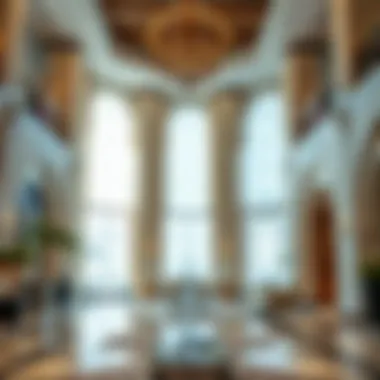

Interior Perspectives
Delving into interior perspectives of the Dar Al Riffa Building brings forth a new layer of understanding. Interior shots capture the design philosophy that marries functionality with beauty. Not merely spaces to inhabit, these interiors celebrate an artful mix of color, light, and texture.
Photographic depictions of open spaces and choreographed layouts illustrate how areas are intended for social interaction, reflecting the communal spirit of Dubai. Large windows allow natural light to flood in, highlighting design features, while the careful placement of furniture facilitates movement and usability.
The contrast between cozy nooks and open areas can be nicely framed in photographs, providing a visual flow that invites viewers to mentally walk through the spaces. This is particularly relevant for real estate agents aiming to showcase the property's unique features to prospective buyers, as the interiors reveal the quality of living one might expect.
Some elements to note in interior photography could be:
- Color palette and materials
- Furniture layouts and design choices
- Natural light dynamics throughout rooms
Details and Close-Ups
Focusing on details and close-up shots adds yet another critical layer to the photographic representation of the Dar Al Riffa Building. These images often highlight unique craftsmanship and textures that might be overlooked from a distance. Close-up photography helps potential buyers appreciate the quality of materials used, such as the fine finishes or artistic embellishments.
A photograph capturing a door handle or the grain of an elegant wooden beam can evoke feelings of warmth and sophistication. Detail shots also play a vital role in fostering emotional connections to the space, allowing viewers to envision themselves within the environment.
The close-ups can also emphasize the integration of technology in the building. Screens, lighting fixtures, and environmental controls can visibly showcase how modern and smart this building truly is, appealing to tech-savvy investors.
Some aspects to capture in detail shots might include:
- High-quality finishes
- Artistic details like moldings or carvings
- Technological integrations that modernize living
As we traverse this photographic journey, it becomes clear how these images contribute significantly to understanding the architectural narrative of the Dar Al Riffa Building. They serve not merely as representations but as a stimulus for potential investment and appreciation of the structure's cultural impact.
Through this exploration of exterior, interior, and detailed shots, we gain a comprehensive understanding of a building that stands as a remarkable aspect of modern Dubai's skyline.
Cultural Significance of the Building
The Dar Al Riffa Building stands as more than just a structural marvel in the bustling city of Dubai. Its cultural significance resonates deeply, reflecting the values, history, and aspirations of the local community. This building is a living testament to the architectural ambitions of the era, showcasing a blend of traditional and modern design philosophies. Beyond its bricks and beams, it embodies the soul of a city that has rapidly transformed from a humble trading port into a global hub.
Impact on Local Community
The presence of the Dar Al Riffa Building has profoundly impacted the local community in various ways. First and foremost, it serves as a landmark, offering a sense of identity and pride to the residents. For many, it’s not just a place to live or work; it’s a symbol of the socio-economic progress that Dubai has enjoyed over the past few decades. When folks gather in nearby parks or cafés, conversations often revolve around the building's architecture or its historical significance, creating a sense of community ties.
Moreover, the building has stimulated local economy. With its establishment, new businesses have sprouted up in its vicinity, providing employment opportunities and enhancing the local lifestyle. From quaint cafés to boutique shops, the area seems to be bustling with activity. Residents reminisce about how, before the building's rise, this neighborhood lacked the vibrancy that it now possesses.
"The Dar Al Riffa isn't just about aesthetics; it impacts lives, economies, and the very fabric of our community."
Additionally, it plays a pivotal role in cultural events. The building often hosts exhibitions, workshops, and cultural festivals that draw in crowds from various backgrounds, promoting artistic expression and cultural exchange. This interaction enriches the community while fostering a sense of belonging.
Representation of Modern Dubai
As a representation of modern Dubai, the Dar Al Riffa Building encapsulates the essence of the city's relentless pursuit of progress and innovation. It’s a visual narrative of how architectural design can capture the spirit of an era. The building reflects modernity through its innovative use of materials and cutting-edge technology, showcasing design elements that are distinctly contemporary yet rooted in the region's historical context.
The juxtaposition of sleek lines and traditional motifs represents the duality of Dubai as a city that honors its past while embracing the future. Investors and home buyers often point to the Dar Al Riffa as a perfect example of how contemporary design can exist harmoniously within an established cultural framework. Many see it as a message that Dubai is not just about skyscrapers but also about preserving the richness of its heritage.
Furthermore, the building plays a vital role in attracting tourism. Visitors flock to see its architectural beauty, and it frequently features in promotional materials for Dubai's real estate sector. It’s a microcosm of the broader trends shaping Dubai’s urban landscape.
Investment Potential
Investing in real estate is often likened to navigating a complex maze; understanding the nuances is crucial for success. The Dar Al Riffa Building stands as a testament to both artistic vision and economic opportunity. Knowing the investment potential of such a landmark can empower investors and buyers alike in making informed decisions. The significance of its architectural style and location are not just about aesthetics; they offer tangible benefits in property value appreciation and rental income.
The market for luxury real estate in Dubai has seen astounding growth and is expected to continue on this upward trajectory. The Dar Al Riffa, with its unique design and strategic positioning, plays a vital role in attracting both local and international investors. A closer look at pivotal factors can shed light on why this building is more than just another structure on the skyline.
Market Trends and Valuation
Market trends remain the pulse of any investment; understanding them can make or break a deal. In recent years, Dubai's real estate market has moved towards a more balanced landscape, showcasing a blend of luxury apartments, commercial spaces, and rental properties. The valuation of the Dar Al Riffa Building reflects these trends, painting a promising picture.
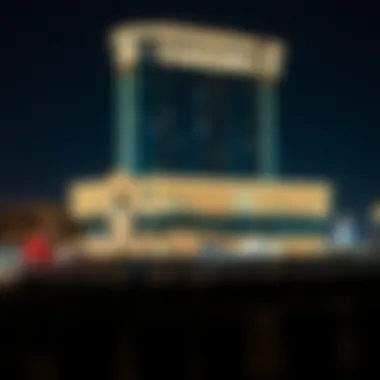

Key indicators include:
- Price per square foot: Analyzing the average cost of similar properties can highlight whether the investment is sound.
- Historical performance: The appreciation of property values over the preceding years can provide insights into future trends.
- Rental demand: Understanding the demand for rental spaces in the vicinity can influence overall property value.
- Regulatory landscape: With ongoing governmental support, particularly in Expo 2020 aftermath, it's worth noting policies aimed at enticing foreign investment.
These elements weave into a broader narrative about the sustainability of returns on investment in the area, making the Dar Al Riffa Building a prime consideration.
Prospects for Buyers and Investors
The Dar Al Riffa isn't just about bricks and mortar; it's the strategic opportunity that potential investors should be eyeing. Buyers looking at this property can consider several aspects that further make it a worthy investment.
- Growth potential: Areas near iconic structures like Dar Al Riffa often see a ripple effect in property demand, likely boosting values long-term.
- Tourism draw: Its architectural significance positions the building as a landmark, attracting visitors and, subsequently, a lively rental market.
- Diverse investment portfolio: Whether looking for a primary residence or a rental unit, this building can enrich a portfolio by providing both lifestyle and investment opportunities.
- Community engagement: Being part of a culturally rich locale adds value, as community aspects often lead to higher interest from potential tenants or homebuyers.
"Timing the market is impossible, but time in the market can be very rewarding."
Exploring historical and projected trends is crucial for making well-informed investment choices. Engaging with market analyses, reports, and local insights can further aid potential investors in navigating this exciting landscape.
For more insights, consider visiting Wikipedia on Dubai's Real Estate or Britannica's overview on property investment.
A well-researched decision can lead to fruitful outcomes, making the Dar Al Riffa Building a conversation starter in any real estate dialogue.
Culmination
The conclusion serves a pivotal role in underscoring the intricate layers associated with the Dar Al Riffa Building. This article delves into not just a structure, but a significant piece of Dubai's architectural tapestry. The importance of this conclusion lies in its synthesis of the core discussions from each section, encompassing historical context, cultural implications, and real estate trends.
Key Takeaways
- Historical Significance: It is essential to appreciate how the Dar Al Riffa Building echoes the rich cultural heritage of Dubai while signifying the rapid urban development of the area.
- Architectural Value: The building’s design philosophy and structural elements not only enhance the skyline but also reflect modern advances in architecture and design.
- Photography's Role: The photographic representation discussed reveals layers of aesthetic and cultural narratives, which deepen our understanding of what the Dar Al Riffa represents today.
"Photography breathes life into architecture, allowing observers to explore dimensions beyond the physical structure."
Investment Considerations
Looking at its investment potential, the Dar Al Riffa Building is positioned uniquely amidst Dubai's evolving real estate market. Understanding current trends, market valuation, and future prospects is critical for potential buyers and investors who are considering properties in this bustling metropolis.
Closing Thoughts
In summary, this article is not merely a collection of facts but a comprehensive exploration that encourages readers to view the Dar Al Riffa Building through both a critical and appreciative lens. The intersection of architectural beauty and cultural significance creates a narrative around the building, making it a worthy subject for anyone interested in real estate, architecture, or the broader socio-economic dynamics of contemporary Dubai.
This understanding of the Dar Al Riffa can foster a deeper connection, guiding individuals in their real estate decisions while appreciating the artistry inherent in urban design.
For more insights and detailed analyses on architectural significance, you may explore resources like Wikipedia, Britannica, and Reddit.
By considering these various elements, the conclusion encapsulates the myriad of benefits and considerations discussed, driving home the significance of the Dar Al Riffa Building within the fabric of Dubai.
Future of the Dar Al Riffa Building
Discussing the future of the Dar Al Riffa Building is vital since it not only represents a landmark of architectural innovation but also reflects trends in urban planning and community development within Dubai. As the city continues to evolve, understanding how this building will fit into the long-term vision and growth strategies of the area becomes essential for investors, property managers, and residents alike.
Preservation Efforts
Preservation efforts for the Dar Al Riffa Building hinge on multiple factors, including maintaining its architectural integrity and ensuring its historical significance does not fade into the background of urban expansion. Local authorities alongside heritage conservationists are working hand-in-hand to ensure the building retains its allure and character amid the rising skyline.
For instance, initiatives aimed at restoring original features, like the intricate facade and the artisanal handiwork inside, are pivotal. Community engagement also plays a crucial role. Awareness campaigns that emphasize the cultural value and historical connection of the building can help mobilize public support for preservation. Key considerations include:
- Regular Maintenance: Routine checks to monitor structural soundness and preventive measures against deterioration.
- Adaptive Reuse: Finding new purposes for the building without compromising its original design, allowing it to serve contemporary needs.
- Education Programs: Informing citizens and tourists about the significance of preserving this architectural masterpiece.
"Preservation is not about hiding the past; it’s about enriching it."
Integration in Urban Development
The integration of the Dar Al Riffa Building into the broader framework of urban development is equally critical. It acts not merely as a standalone structure but as a cohesive thread in the urban fabric of Dubai. As the city continues its rapid pace of growth, strategic planning will be necessary to harmonize historic sites like Dar Al Riffa with new developments. Important points to consider include:
- Zoning Regulations: Establishing policies that respect and protect heritage buildings from being overshadowed by towering skyscrapers.
- Mixed-Use Development: Promoting projects that encourage a blend of residential, commercial, and recreational spaces to create a vibrant surroundings.
- Green Spaces: Incorporating parks or public areas nearby that enhance the building’s accessibility and promote community use.
The future of the Dar Al Riffa Building, intertwined with its preservation and integration, will undoubtedly shape not just its own destiny but also that of the surrounding community. Stakeholders must take into account these aspects to ensure that it remains a cherished icon in Dubai's cultural and architectural landscape.




